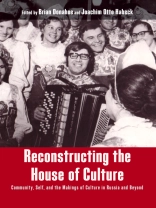Notions of culture, rituals and their meanings, the workings of ideology in everyday life, public representations of tradition and ethnicity, and the social consequences of economic transition— these are critical issues in the social anthropology of Russia and other postsocialist countries. Engaged in the negotiation of all these is the House of Culture, which was the key institution for cultural activities and implementation of state cultural policies in all socialist states. The House of Culture was officially responsible for cultural enlightenment, moral edification, and personal cultivation—in short, for implementing the socialist state’s program of “bringing culture to the masses.” Surprisingly, little is known about its past and present condition. This collection of ethnographically rich accounts examines the social significance and everyday performance of Houses of Culture and how they have changed in recent decades. In the years immediately following the end of the Soviet Union, they underwent a deep economic and symbolic crisis, and many closed. Recently, however, there have been signs of a revitalization of the Houses of Culture and a re-orientation of their missions and programs. The contributions to this volume investigate the changing functions and meanings of these vital institutions for the communities that they serve.
Spis treści
List of Illustrations
Editors’ Preface
A Note on Transliteration
Introduction: Cultivation, Collective, and the Self
Joachim Otto Habeck
Part I: The Siberian House of Culture in Comparative Perspective
Chapter 1. From Collective Enthusiasm to Individual Self-Realization: History of and Experience in the House of Culture, Anadyr’ (Chukotka)
Virginie Vaté and Galina Diatchkova
Chapter 2. “Thank You for Being”: Neighborhood, Ethno-Culture, and Social Recognition in the House of Culture
Joachim Otto Habeck
Chapter 3. Pokazukha in the House of Culture: The Pattern of Behavior in Kurumkan, Eastern Buriatiia
István Sántha and Tatiana Safonova
Chapter 4. Three Houses of Culture in Kosh-Agach: Accounting for Culture Work in a Changing Political Setting
Agnieszka Halemba
Chapter 5. In the Face of Adversity: Shagonar’s Culture Workers Bear the Torch of Culture
Brian Donahoe
Chapter 6. Constellations of Culture Work in Present-Day Siberia
Joachim Otto Habeck, Brian Donahoe, and Siegfried Gruber
Part II: Expanding the Stage: The House of Culture in Broader Historical and Geographical Context
Chapter 7. The Emergence of the Soviet Houses of Culture in Kyrgyzstan
Ali İğmen
Chapter 8. Palana’s House of Koryak Culture
Alexander D. King
Chapter 9. Transformations of the House of Culture in Civil Society: A Case Study of Rural Women’s Culture Projects in Latvia
Aivita Putnina
Chapter 10. Heritage House-Guarding as Sustainable Development: Community Arts and Architectures within a World Cultural Net(work)
Nadezhda Savova
Epilogue: Recognizing Soviet Culture
Bruce Grant
Appendix I: Research Design and Methodology of the Comparative Research Project “The Social Significance of the House of Culture”
B. Donahoe, J.O. Habeck, A. Halemba, K. Istomin, I. Sántha, and V. Vaté
Appendix II: Survey Form and Instructions
Appendix III: Questionnaire 1 (Q1) and Instructions
Appendix IV: Questionnaire 2 (Q2) and Instructions
Appendix V: Fieldwork Checklist
Notes on Contributors
Index
O autorze
Brian Donahoe is an independent researcher living in Kyzyl, Republic of Tyva. From 2004–2010 he was a postdoctoral research fellow at the Max Planck Institute for Social Anthropology in Halle, Germany. His research interests include the interaction between the Russian legal system and Russia’s indigenous peoples, and the dynamics of constructing, maintaining, and performing ethnic identity and indigeneity through the idioms of “culture and tradition.”












